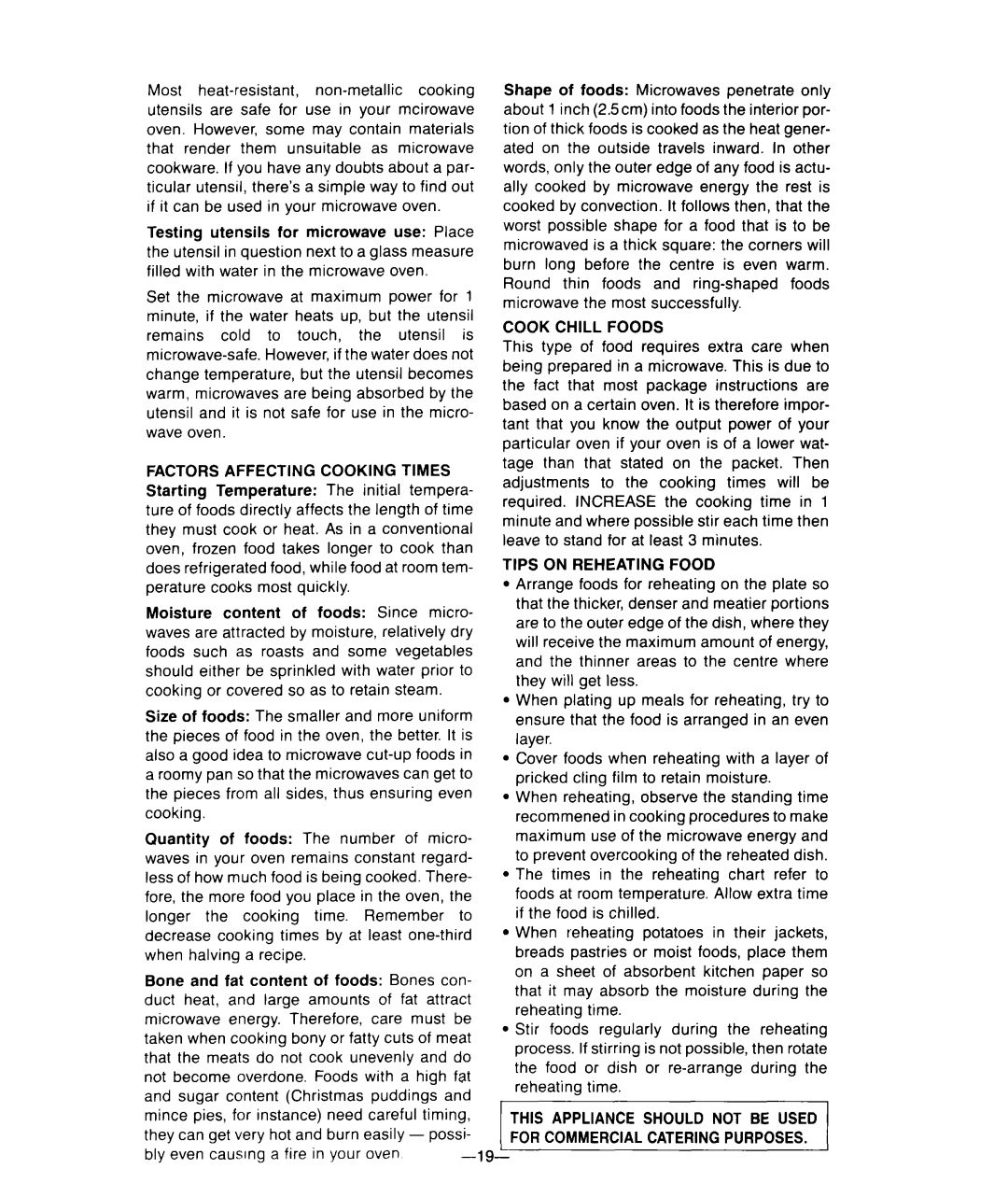
Most
Testing utensils for microwave use: Place the utensil in question next to a glass measure filled with water in the microwave oven.
Set the microwave at maximum power for 1 minute, if the water heats up, but the utensil remains cold to touch, the utensil is
FACTORS AFFECTING COOKING TIMES Starting Temperature: The initial tempera- ture of foods directly affects the length of time they must cook or heat. As in a conventional oven, frozen food takes longer to cook than does refrigerated food, while food at room tem- perature cooks most quickly.
Moisture content of foods: Since micro- waves are attracted by moisture, relatively dry foods such as roasts and some vegetables should either be sprinkled with water prior to cooking or covered so as to retain steam.
Size of foods: The smaller and more uniform the pieces of food in the oven, the better. It is also a good idea to microwave
Quantity of foods: The number of micro- waves in your oven remains constant regard- less of how much food is being cooked. There- fore, the more food you place in the oven, the longer the cooking time. Remember to decrease cooking times by at least
Bone and fat content of foods: Bones con- duct heat, and large amounts of fat attract microwave energy. Therefore, care must be taken when cooking bony or fatty cuts of meat that the meats do not cook unevenly and do not become overdone. Foods with a high fat and sugar content (Christmas puddings and mince pies, for instance) need careful timing, they can get very hot and burn easily - possi-
bly even causing a fire In your oven |
Shape of foods: Microwaves penetrate only about 1 inch (2Scm) into foods the interior por- tion of thick foods is cooked as the heat gener- ated on the outside travels inward. In other words, only the outer edge of any food is actu- ally cooked by microwave energy the rest is cooked by convection. It follows then, that the worst possible shape for a food that is to be microwaved is a thick square: the corners will burn long before the centre is even warm. Round thin foods and
COOK CHILL FOODS
This type of food requires extra care when being prepared in a microwave. This is due to the fact that most package instructions are based on a certain oven. It is therefore impor- tant that you know the output power of your particular oven if your oven is of a lower wat- tage than that stated on the packet. Then adjustments to the cooking times will be required. INCREASE the cooking time in 1 minute and where possible stir each time then leave to stand for at least 3 minutes.
TIPS ON REHEATING FOOD
l Arrange foods for reheating on the plate so that the thicker, denser and meatier portions are to the outer edge of the dish, where they will receive the maximum amount of energy, and the thinner areas to the centre where they will get less.
l When plating up meals for reheating, try to ensure that the food is arranged in an even layer.
l Cover foods when reheating with a layer of pricked cling film to retain moisture.
l When reheating, observe the standing time recommened in cooking procedures to make maximum use of the microwave energy and to prevent overcooking of the reheated dish. l The times in the reheating chart refer to foods at room temperature. Allow extra time
if the food is chilled.
l When reheating potatoes in their jackets, breads pastries or moist foods, place them on a sheet of absorbent kitchen paper so that it may absorb the moisture during the reheating time.
l Stir foods regularly during the reheating process. If stirring is not possible, then rotate the food or dish or
THIS APPLIANCE SHOULD NOT BE USED FOR COMMERCIAL CATERING PURPOSES.
